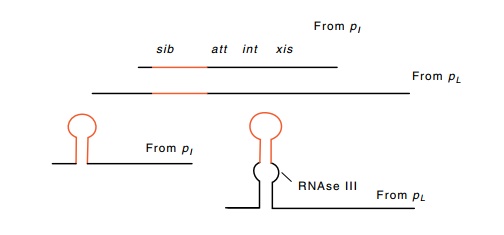Chapter: Genetics and Molecular Biology: Lambda Phage Integration and Excision
Inhibition By a Downstream Element
Inhibition By a Downstream Element
A lambda phage not integrated into the
host chromosome and proceed-ing down the lytic pathway would do well to
minimize its synthesis of Int protein. On the other hand, an induced lambda
located in the chromosome has great need for Int protein to assist in excision.
How could the phage know whether or not it is integrated into the chromo-some
and how could it therefore adjust Int protein synthesis? In both situations,
the int-specific promoter pI is off and the synthesis and
regulation of Int and Xis proteins derives from the pL promoter.
The
location of the b2 region of the
phage signals whether it is integrated in the chromosome or is free in the
cytoplasm. When the phage has excised it is circular, and the b2 region is adjacent to the int gene (Fig. 18.12). On the other
hand, when the phage is integrated, host DNA is adjacent to the int gene. These two situations have
different

Figure
18.12 Sibis not part of theintmessenger when lambda is
transcribedas a lysogen.
effects
on the translation efficiency of int
messenger deriving from the pLpromoter.
A sequence called sib lying in the b2 region is transcribedand becomes
part of the int messenger only when
the phage is not integrated. This sequence inhibits translation of the int message.
The
synthesis of Int and Xis proteins was characterized in cells that had been
exposed with a low dose of UV light to block host-encoded protein synthesis.
These cells were then infected with phage, and radio-active amino acids were
added. At various times, samples were taken and subjected to SDS polyacrylamide
gel electrophoresis. The Int and Xis proteins were easily detected and
quantitated by autoradiography. Alternatively, no UV light was used, and
instead the Int or Xis proteins were precipitated with antibody, further
separated from the other proteins by the electrophoresis, and finally
quantitated from autora-diographs.
Infection
by wild-type lambda yields only a low synthesis of Int protein, but infection
by λb2 yields
high synthesis of Int protein. Point mutations and deletions have been isolated
that yield high levels of Int protein following infection. These narrowly
define a region in the b2 region
called sib which is responsible for
the altered synthesis rate of Int. The deletions and point mutations have a
strictly cis effect on Int protein
synthesis. Therefore the effect is called downstream or retro-in-hibition
because it acts backward on expression of the preceding gene.
The sib region contains a typical
transcription termination sequence, and the sib
mutations alter the structure of the RNAse III-sensitive structure that can be
formed in messenger that initiates from pL
(Fig. 18.13). Transcripts initiated at pI
normally terminate near the end of this region, but the transcripts initiated at pL ignore termination signals because of the phage N
protein bound to RNA polymerase, and the

Figure
18.13 Secondary structures of thesibregion in transcripts originatingfrom
pI and pL. The promoter pI lies just ahead of xis, so the transcription start point does not include all of xis.
transcription
continues past this region. The pL-initiated
transcripts are capable of forming an additional base-paired region that is
sensitive to RNAse III. This enzyme that cleaves special double-stranded RNA
structures. The transcripts initiated at pI
do not form the RNAse III-sen-sitive structure. Most likely, then, cleavage by
RNAse III leads to degra-dation of the adjacent int gene messenger. As expected, the sib effect is absent in RNAse III-defective mutants.
Related Topics